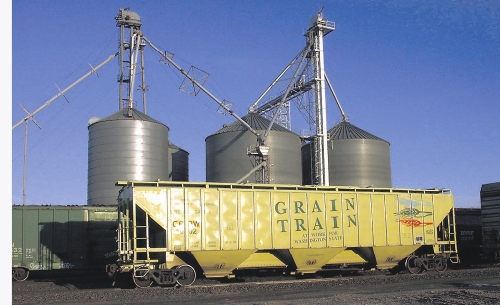forum
library
tutorial
contact

Russia-Ukraine Uncertainty
Pushes Wheat Prices Higher
by Matthew Weaver
Capital Press, February 24, 2022
|
the film forum library tutorial contact |

|
Russia-Ukraine Uncertainty
by Matthew Weaver
|
"This is the highest the wheat futures have been since 2012."
-- Byron Behne, senior merchant at Northwest Grain Growers in Walla Walla, Washington
 Uncertainty over Russia's invasion of Ukraine pushed wheat futures higher this week, but market analysts aren't sure how high they'll go.
Uncertainty over Russia's invasion of Ukraine pushed wheat futures higher this week, but market analysts aren't sure how high they'll go.
Both nations are major wheat producers.
"It is 'top of the fold' and the only story that is trading right now," said Dan Steiner, grain merchant at Morrow County Grain Growers in Oregon.
December wheat futures prices were about $8.78 on the Chicago market Feb. 23. Futures have increased by 79 to 94 cents during the past several days, analysts said.
"You don't see this happen very often," said Byron Behne, senior merchant at Northwest Grain Growers in Walla Walla, Wash. "It is similar to the move that happened in 2014," when Russia annexed the Crimean Peninsula from Ukraine.
At that time, wheat prices were below $6 per bushel, but rose to more than $7 per bushel, Behne said.
"I don't know the size of this move, given we were starting at $8, what to expect here," he said. "This is the highest the wheat futures have been since 2012."
Old-crop white wheat cash prices haven't been affected, Behne said.
"It's kind of been on its own planet all year just because of the small crop," he said, adding that the Ukraine crisis has helped the new crop white wheat prices more.
On the cash market, soft white wheat prices ranged from $10.50 to $11.05 per bushel this week at Portland. They ranged from $10.20 to $11.50 a month ago.
"No idea on how high they might go," said Darin Newsom, a wheat analyst in Omaha, Neb. "It depends on how the situation escalates. Right now, wheat is just one market out of many that nobody wants to sell. In markets devoid of selling, there's no way of picking a top."
Russia and Ukraine export about 30% of the world's wheat, raising concern about the potential impact to Black Sea ports.
Any wheat coming out of the Black Sea region must move through the Bosporus strait near Istanbul, Turkey, Steiner said.
"There's a couple chokepoints that are pretty important," Steiner said. "You start sailing warships around and this is a major conflict that blows up, the United States is really the only other viable place that has a supply of exportable quantity and quality of wheat."
But the U.S., Canada and Australia have had their own production issues in recent years. If Russia and Ukraine's production is suddenly off the market, those countries will have to cover some of that business, Newsom said.
"There's no reason to sell (wheat at) $8.50, $8.60, $8.70 (per bushel) if it's going to go up to $9.50, $10, $10.50," he said. "We won't ever run out of wheat -- globally, it's just not going to happen, but we are tightening the supplies."
Early U.S. wheat scores indicate poor crops in Kansas, Oklahoma, South Dakota and Texas, Steiner said. He expects an overall below-average crop out of the Pacific Northwest.
"The reality is, I think there's room for prices to go higher," he said. "I certainly wouldn't want to short this market."
Until a good Northern Hemisphere wheat crop is secured, prices have a reason to be higher than normal, Behne echoed.
He recommends wheat farmers contract new crop sales for cash or with hedge to arrive contracts in which farmers promise to deliver wheat at a set time and the elevator establishes a hedge.
"In history, you don't get very many opportunities to forward contract new crop wheat at $9," he said.
The biggest questions are whether Russia is conducting a broader invasion of Ukraine or whether it stays in the areas annexed in 2014, Behne said.
"I don't know what happens if they go outside of those boundaries," he said. "The market obviously probably continues to freak out for a while."
It's also unclear how U.S. sanctions might affect Russian grains, since food or humanitarian aid are not typically covered, Behne said.
"Is Russian wheat going to still be available to the market this spring?" he asked. "Is Russia going to decide they don't want to export wheat if everyone's mad at them? Who knows?"
Russia is slated to have a large wheat crop, Behne said.
"If this thing doesn't turn into World War III, probably whatever's going to happen is going to be solved by the time we get to harvest and Russian wheat is probably available to the market," he said. "This is probably temporary. Now, temporary meaning, does this last a few weeks? A few months? I don't know."
learn more on topics covered in the film
see the video
read the script
learn the songs
discussion forum
